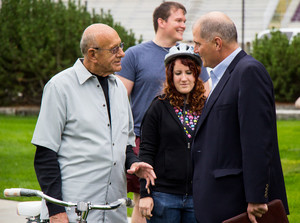Reverse steering bike teaches CSC students about their brains

CHADRON – Habits are hard to break, even when you know it’s necessary.
That’s a lesson Chadron State College education faculty member Marv Neuharth tried to teach students in a visceral way by having them try to ride a reverse steering bicycle in September.
Reverse steering bicycles use two gears, one on the bike’s steering column and one attached to the handlebars, to change the normal way of heading a bike in the direction you want it to go.
“When you turn the handlebars to the left, the front wheel goes to the right; when you turn the handlebars to the right, it goes left,” said Neuharth, an avid cyclist himself.
Neuharth said he learned about reverse steering bikes a few years back from a colleague, and after seeing one in action on a YouTube video, got the idea of using it in his psychology classes. A nephew in Colorado happened to know a group of machinists who had made one of the unorthodox vehicles, and was able to borrow it and bring it to Chadron. After using the borrowed bike a while, Neuharth had his own version constructed by a local shop.
In psychology class, Neuharth said, there is considerable emphasis on the cerebellum – the part of the brain that consolidates sensory inputs and plays a major role in movement-related functions such as coordination and timing.
“To me, the cerebellum is a fascinating component of our brain,” he said. “We talk a lot about the cerebellum in class, and how, when we perform a behavior, whether physical or psychological, it can be imprinted in our brain.”
Students get a demonstration of the strength of that imprinting from trying to ride a reverse steering bike.
“When you get on it and stumble along with your feet on the ground, you can pretty much control it but as soon as you put your feet on the pedals, you are done,” he said.
Students aren’t required to attempt riding the bike, and those who do are equipped with helmets and knee pads for safety. Of those who take up the challenge, experienced cyclists are more likely to think they can ride the bike, and then seem to have the most trouble with it, said Neuharth.
“They are surprised at how difficult it is,” he said.
Neuharth believes that is because an experienced rider’s actions are more strongly ingrained in their brain than someone who hasn’t biked much.
“It’s the little corrections we make when we get on a bike to keep in balance. What throws us off is it’s the opposite of what we are accustomed to,” he said. “Patterns are more important than we think in behavior.”
So far, none of Neuharth’s students have been able to ride the bike, and he hasn’t either. He’s seen a video of a person who mastered the skill, but said that individual admitted having trouble riding a normal bike afterward.
“He couldn’t ride a regular bike because he had reprogrammed his brain,” said Neuharth.
The reverse steering bike gives students a direct experience of the power that repetition and habit play in people’s lives, said Neuharth, and he hopes they will then begin to understand why getting a person to change their behavior can be so difficult.
“We can all impulsively engage in inappropriate behavior, but when we engage over and over, it becomes a pattern. Reinforcing patterns plays a large part in individual behavior,” he said. “Whether its psychological, or physical or emotional behavior, when these are ingrained, it’s so difficult to change.”
Category: Campus Events, Campus News, Psychological Sciences


